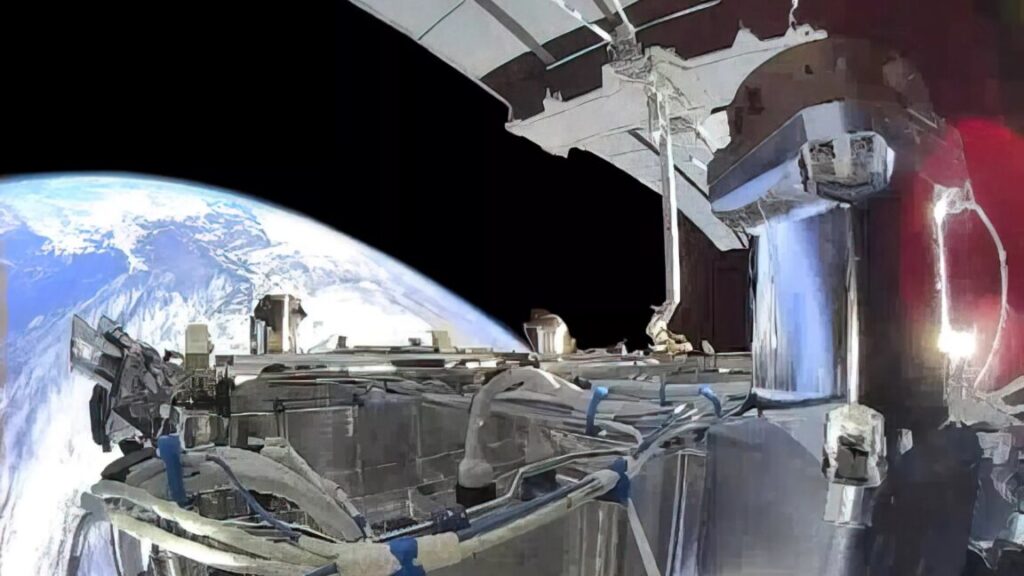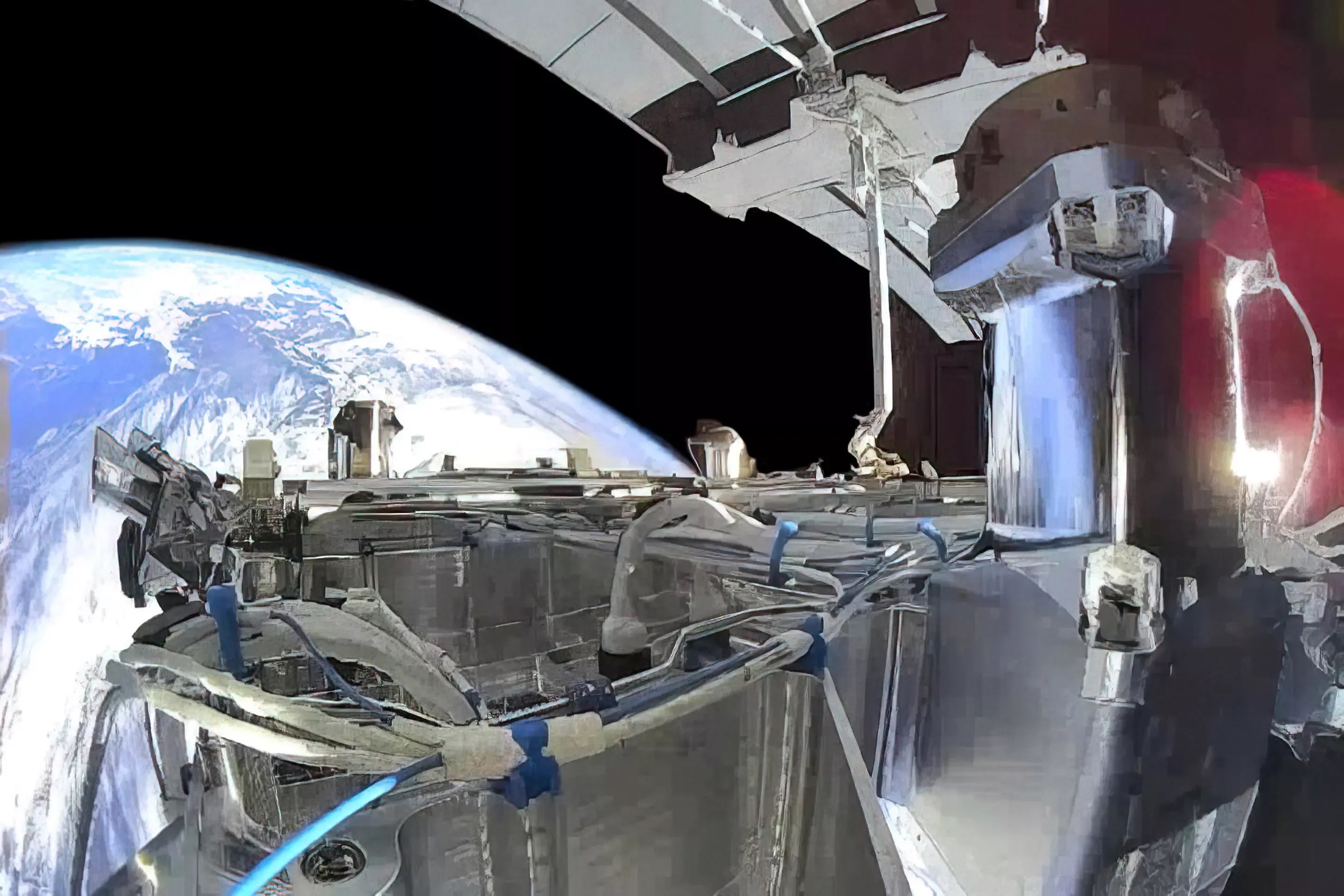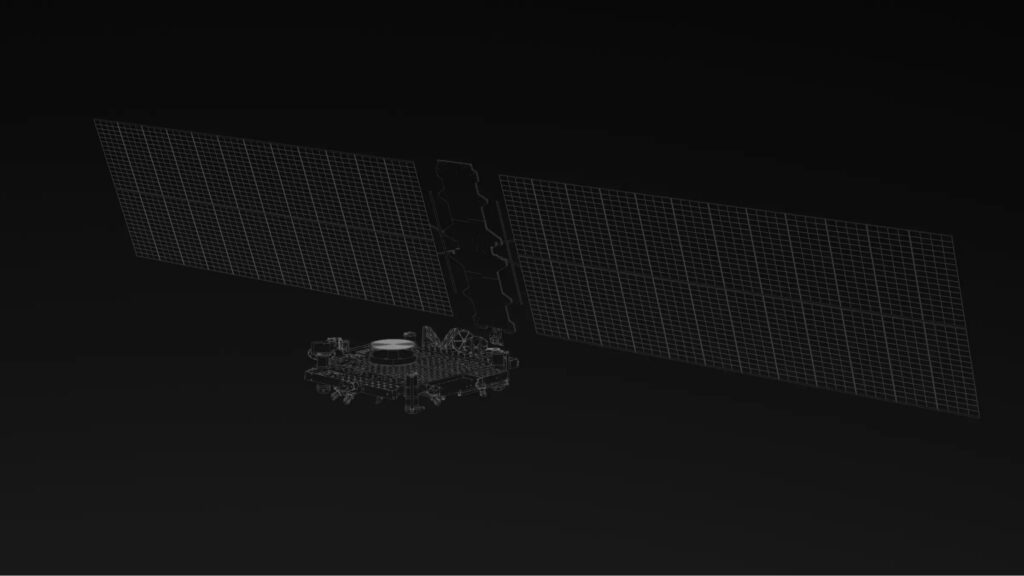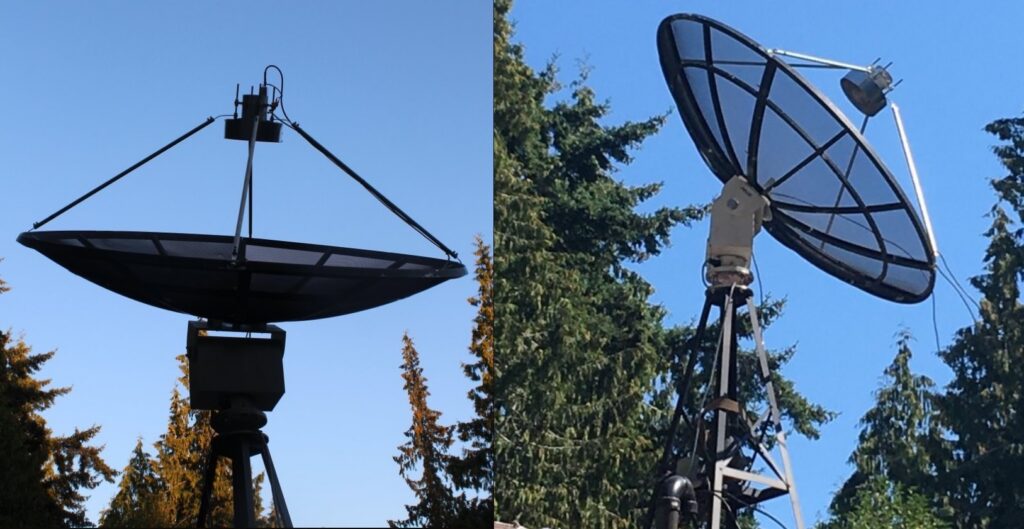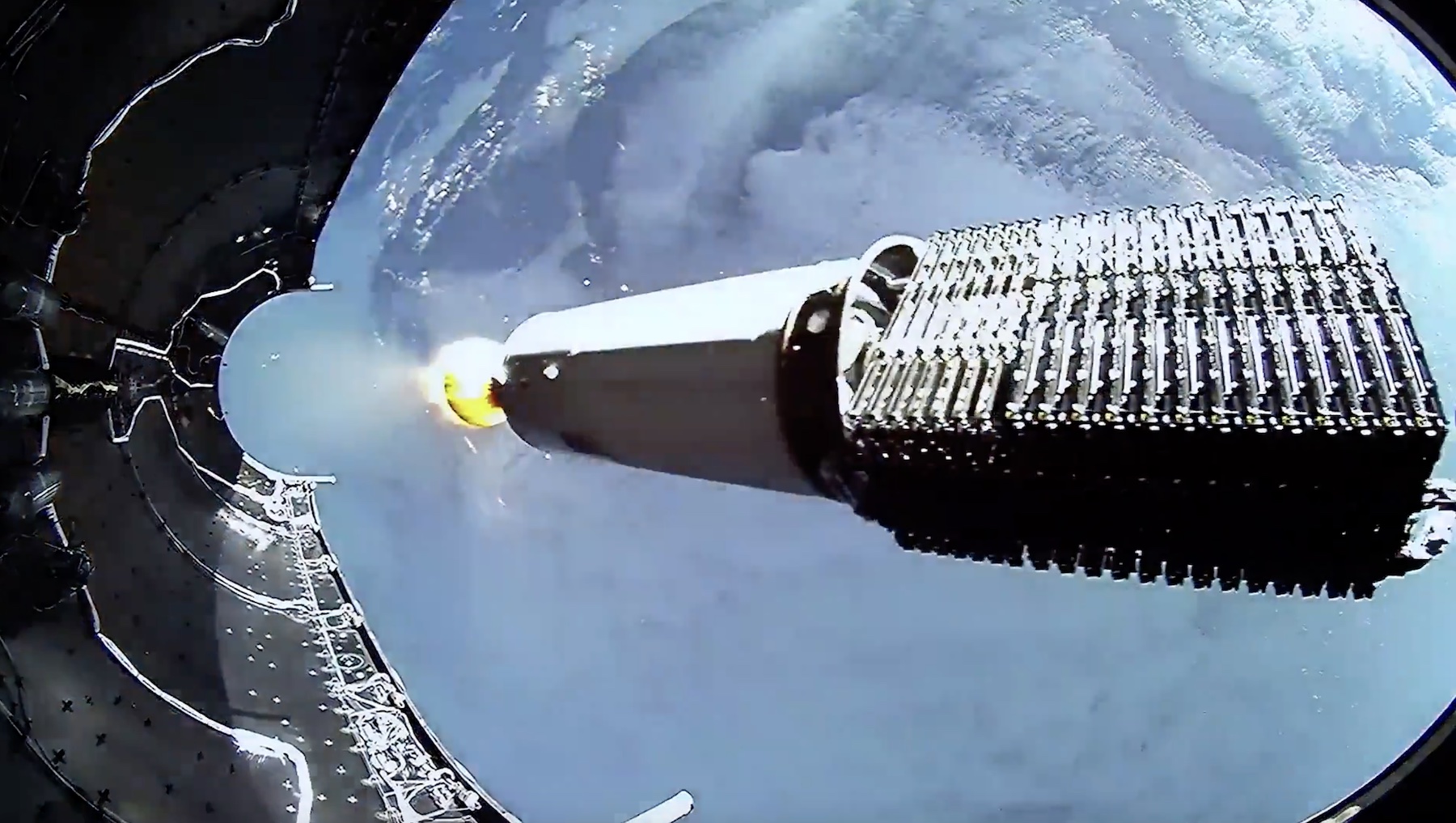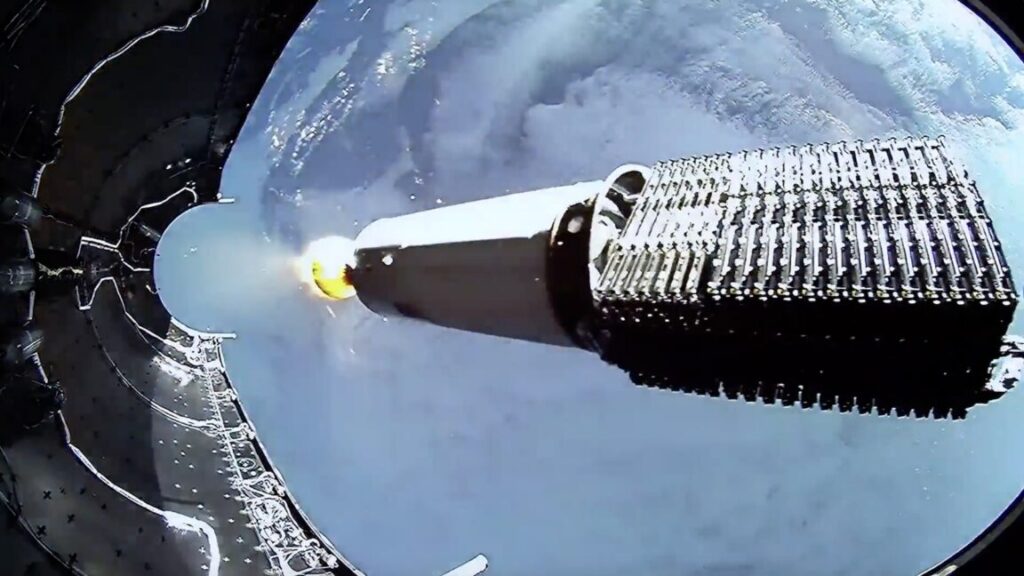US spy satellites built by SpaceX send signals in the “wrong direction”
About 170 Starshield satellites built by SpaceX for the US government’s National Reconnaissance Office (NRO) have been sending signals in the wrong direction, a satellite researcher found.
The SpaceX-built spy satellites are helping the NRO greatly expand its satellite surveillance capabilities, but the purpose of these signals is unknown. The signals are sent from space to Earth in a frequency band that’s allocated internationally for Earth-to-space and space-to-space transmissions.
There have been no public complaints of interference caused by the surprising Starshield emissions. But the researcher who found them says they highlight a troubling lack of transparency in how the US government manages the use of spectrum and a failure to coordinate spectrum usage with other countries.
Scott Tilley, an engineering technologist and amateur radio astronomer in British Columbia, discovered the signals in late September or early October while working on another project. He found them in various parts of the 2025–2110 MHz band, and from his location, he was able to confirm that 170 satellites were emitting the signals over Canada, the United States, and Mexico. Given the global nature of the Starshield constellation, the signals may be emitted over other countries as well.
“This particular band is allocated by the ITU [International Telecommunication Union], the United States, and Canada primarily as an uplink band to spacecraft on orbit—in other words, things in space, so satellite receivers will be listening on these frequencies,” Tilley told Ars. “If you’ve got a loud constellation of signals blasting away on the same frequencies, it has the potential to interfere with the reception of ground station signals being directed at satellites on orbit.”
In the US, users of the 2025–2110 MHz portion of the S-Band include NASA and the National Oceanic and Atmospheric Administration (NOAA), as well as nongovernmental users like TV news broadcasters that have vehicles equipped with satellites to broadcast from remote locations.
Experts told Ars that the NRO likely coordinated with the US National Telecommunications and Information Administration (NTIA) to ensure that signals wouldn’t interfere with other spectrum users. A decision to allow the emissions wouldn’t necessarily be made public, they said. But conflicts with other governments are still possible, especially if the signals are found to interfere with users of the frequencies in other countries.
Surprising signals
Scott Tilley and his antennas. Credit: Scott Tilley
Tilley previously made headlines in 2018 when he located a satellite that NASA had lost contact with in 2005. For his new discovery, Tilley published data and a technical paper describing the “strong wideband S-band emissions,” and his work was featured by NPR on October 17.
Tilley’s technical paper said emissions were detected from 170 satellites out of the 193 known Starshield satellites. Emissions have since been detected from one more satellite, making it 171 out of 193, he told Ars. “The apparent downlink use of an uplink-allocated band, if confirmed by authorities, warrants prompt technical and regulatory review to assess interference risk and ensure compliance” with ITU regulations, Tilley’s paper said.
Tilley said he uses a mix of omnidirectional antennas and dish antennas at his home to receive signals, along with “software-defined radios and quite a bit of proprietary software I’ve written or open source software that I use for analysis work.” The signals did not stop when the paper was published. Tilley said the emissions are powerful enough to be received by “relatively small ground stations.”
Tilley’s paper said that Starshield satellites emit signals with a width of 9 MHz and signal-to-noise (SNR) ratios of 10 to 15 decibels. “A 10 dB SNR means the received signal power is ten times greater than the noise power in the same bandwidth,” while “20 dB means one hundred times,” Tilley told Ars.
Other Starshield signals that were 4 or 5 MHz wide “have been observed to change frequency from day to day with SNR exceeding 20dB,” his paper said. “Also observed from time to time are other weaker wide signals from 2025–2110 MHz what may be artifacts or actual intentional emissions.”
The 2025–2110 MHz band is used by NASA for science missions and by other countries for similar missions, Tilley noted. “Any other radio activity that’s occurring on this band is intentionally limited to avoid causing disruption to its primary purpose,” he said.
The band is used for some fully terrestrial, non-space purposes. Mobile service is allowed in 2025–2110 MHz, but ITU rules say that “administrations shall not introduce high-density mobile systems” in these frequencies. The band is also licensed in the US for non-federal terrestrial services, including the Broadcast Auxiliary Service, Cable Television Relay Service, and Local Television Transmission Service.
While Earth-based systems using the band, such as TV links from mobile studios, have legal protection against interference, Tilley noted that “they normally use highly directional and local signals to link a field crew with a studio… they’re not aimed into space but at a terrestrial target with a very directional antenna.” A trade group representing the US broadcast industry told Ars that it hasn’t observed any interference from Starshield satellites.
“There without anybody knowing it”
Spectrum consultant Rick Reaser told Ars that Starshield’s space-to-Earth transmissions likely haven’t caused any interference problems. “You would not see this unless you were looking for it, or if it turns out that your receiver looks for everything, which most receivers aren’t going to do,” he said.
Reaser said it appears that “whatever they’re doing, they’ve come up with a way to sort of be there without anybody knowing it,” or at least until Tilley noticed the signals.
“But then the question is, can somebody prove that that’s caused a problem?” Reaser said. Other systems using the same spectrum in the correct direction probably aren’t pointed directly at the Starshield satellites, he said.
Reaser’s extensive government experience includes managing spectrum for the Defense Department, negotiating a spectrum-sharing agreement with the European Union, and overseeing the development of new signals for GPS. Reaser said that Tilley’s findings are interesting because the signals would be hard to discover.
“It is being used in the wrong direction, if they’re coming in downlink, that’s supposed to be an uplink,” Reaser said. As for what the signals are being used for, Reaser said he doesn’t know. “It could be communication, it could be all sorts of things,” he said.
Tilley’s paper said the “results raise questions about frequency-allocation compliance and the broader need for transparent coordination among governmental, commercial, and scientific stakeholders.” He argues that international coordination is becoming more important because of the ongoing deployment of large constellations of satellites that could cause harmful interference.
“Cooperative disclosure—without compromising legitimate security interests—will be essential to balance national capability with the shared responsibility of preserving an orderly and predictable radio environment,” his paper said. “The findings presented here are offered in that spirit: not as accusation, but as a public-interest disclosure grounded in reproducible measurement and open analysis. The data, techniques, and references provided enable independent verification by qualified parties without requiring access to proprietary or classified information.”
While Tilley doesn’t know exactly what the emissions are for, his paper said the “signal characteristics—strong, coherent, and highly predictable carriers from a large constellation—create the technical conditions under which opportunistic or deliberate PNT exploitation could occur.”
PNT refers to Positioning, Navigation, and Timing (PNT) applications. “While it is not suggested that the system was designed for that role, the combination of wideband data channels and persistent carrier tones in a globally distributed or even regionally operated network represents a practical foundation for such use, either by friendly forces in contested environments or by third parties seeking situational awareness,” the paper said.
Emissions may have been approved in secret
Tilley told us that a few Starshield satellites launched just recently, in late September, have not emitted signals while moving toward their final orbits. He said this suggests the emissions are for an “operational payload” and not merely for telemetry, tracking, and control (TT&C).
“This could mean that [the newest satellites] don’t have this payload or that the emissions are not part of TT&C and may begin once these satellites achieve their place within the constellation,” Tilley told Ars. “If these emissions are TT&C, you would expect them to be active especially during the early phases of the mission, when the satellites are actively being tested and moved into position within the constellation.”
Whatever they’re for, Reaser said the emissions were likely approved by the NTIA and that the agency would likely have consulted with the Federal Communications Commission. For federal spectrum use, these kinds of decisions aren’t necessarily made public, he said.
“NRO would have to coordinate that through the NTIA to make sure they didn’t have an interference problem,” Reaser said. “And by the way, this happens a lot. People figure out a way [to transmit] on what they call a non-interference basis, and that’s probably how they got this approved. They say, ‘listen, if somebody reports interference, then you have to shut down.’”
Tilley said it’s clear that “persistent S-band emissions are occurring in the 2025–2110 MHz range without formal ITU coordination.” Claims that the downlink use was approved by the NTIA in a non-public decision “underscore, rather than resolve, the transparency problem,” he told Ars.
An NTIA spokesperson declined to comment. The NRO and FCC did not provide any comment in response to requests from Ars.
SpaceX just “a contractor for the US government”
Randall Berry, a Northwestern University professor of electrical and computer engineering, agreed with Reaser that it’s likely the NTIA approved the downlink use of the band and that this decision was not made public. Getting NTIA clearance is “the proper way this should be done,” he said.
“It would be surprising if NTIA was not aware, as Starshield is a government-operated system,” Berry told Ars. While NASA and other agencies use the band for Earth-to-space transmissions, “they may have been able to show that the Starshield space-to-Earth signals do not create harmful interference with these Earth-to-space signals,” he said.
There is another potential explanation that is less likely but more sinister. Berry said it’s possible that “SpaceX did not make this known to NTIA when the system was cleared for federal use.” Berry said this would be “surprising and potentially problematic.”
SpaceX rendering of a Starshield satellite. Credit: SpaceX
Tilley doesn’t think SpaceX is responsible for the emissions. While Starshield relies on technology built for the commercial Starlink broadband system of low Earth orbit satellites, Elon Musk’s space company made the Starshield satellites in its role as a contractor for the US government.
“I think [SpaceX is] just operating as a contractor for the US government,” Tilley said. “They built a satellite to the government specs provided for them and launched it for them. And from what I understand, the National Reconnaissance Office is the operator.”
SpaceX did not respond to a request for comment.
TV broadcasters conduct interference analysis
TV broadcasters with news trucks that use the same frequencies “protect their band vigorously” and would have reported interference if it was affecting their transmissions, Reaser said. This type of spectrum use is known as Electronic News Gathering (ENG).
The National Association of Broadcasters told Ars that it “has been closely tracking recent reports concerning satellite downlink operation in the 2025–2110 MHz frequency band… While it’s not clear that satellite downlink operations are authorized by international treaty in this range, such operations are uncommon, and we are not aware of any interference complaints related to downlink use.”
The NAB investigated after Tilley’s report. “When the Tilley report first surfaced, NAB conducted an interference analysis—based on some assumptions given that Starshield’s operating parameters have not been publicly disclosed,” the group told us. “That analysis found that interference with ENG systems is unlikely. We believe the proposed downlink operations are likely compatible with broadcaster use of the band, though coordination issues with the International Telecommunication Union (ITU) could still arise.”
Tilley said that a finding of interference being unlikely “addresses only performance, not legality… coordination conducted only within US domestic channels does not meet international requirements under the ITU Radio Regulations. This deployment is not one or two satellites, it is a distributed constellation of hundreds of objects with potential global implications.”
Canada agency: No coordination with ITU or US
When contacted by Ars, an ITU spokesperson said the agency is “unable to provide any comment or additional information on the specific matter referenced.” The ITU said that interference concerns “can be formally raised by national administrations” and that the ITU’s Radio Regulations Board “carefully examines the specifics of the case and determines the most appropriate course of action to address it in line with ITU procedures.”
The Canadian Space Agency (CSA) told Ars that its “missions operating within the frequency band have not yet identified any instances of interference that negatively impact their operations and can be attributed to the referenced emissions.” The CSA indicated that there hasn’t been any coordination with the ITU or the US over the new emissions.
“To date, no coordination process has been initiated for the satellite network in question,” the CSA told Ars. “Coordination of satellite networks is carried out through the International Telecommunication Union (ITU) Radio Regulation, with Innovation, Science and Economic Development Canada (ISED) serving as the responsible national authority.”
The European Space Agency also uses the 2025–2100 band for TT&C. We contacted the agency but did not receive any comment.
The lack of coordination “remains the central issue,” Tilley told Ars. “This band is globally allocated for Earth-to-space uplinks and limited space-to-space use, not continuous space-to-Earth transmissions.”
NASA needs protection from interference
An NTIA spectrum-use report updated in 2015 said NASA “operates earth stations in this band for tracking and command of manned and unmanned Earth-orbiting satellites and space vehicles either for Earth-to-space links for satellites in all types of orbits or through space-to-space links using the Tracking Data and Relay Satellite System (TDRSS). These earth stations control ninety domestic and international space missions including the Space Shuttle, the Hubble Space Telescope, and the International Space Station.”
Additionally, the NOAA “operates earth stations in this band to control the Geostationary Operational Environmental Satellite (GOES) and Polar Operational Environmental Satellite (POES) meteorological satellite systems,” which collect data used by the National Weather Service. We contacted NASA and NOAA, but neither agency provided comment to Ars.
NASA’s use of the band has increased in recent years. The NTIA told the FCC in 2021 that 2025–2110 MHz is “heavily used today and require[s] extensive coordination even among federal users.” The band “has seen dramatically increased demand for federal use as federal operations have shifted from federal bands that were repurposed to accommodate new commercial wireless broadband operations.”
A 2021 NASA memo included in the filing said that NASA would only support commercial launch providers using the band if their use was limited to sending commands to launch vehicles for recovery and retrieval purposes. Even with that limit, commercial launch providers would cause “significant interference” for existing federal operations in the band if the commercial use isn’t coordinated through the NTIA, the memo said.
“NASA makes extensive use of this band (i.e., currently 382 assignments) for both transmissions from earth stations supporting NASA spacecraft (Earth-to-space) and transmissions from NASA’s Tracking and Data Relay Satellite System (TDRSS) to user spacecraft (space-to-space), both of which are critical to NASA operations,” the memo said.
In 2024, the FCC issued an order allowing non-federal space launch operations to use the 2025–2110 MHz band on a secondary basis. The allocation is “limited to space launch telecommand transmissions and will require commercial space launch providers to coordinate with non-Federal terrestrial licensees… and NTIA,” the FCC order said.
International non-interference rules
While US agencies may not object to the Starshield emissions, that doesn’t guarantee there will be no trouble with other countries. Article 4.4 of ITU regulations says that member nations may not assign frequencies that conflict with the Table of Frequency Allocations “except on the express condition that such a station, when using such a frequency assignment, shall not cause harmful interference to, and shall not claim protection from harmful interference caused by, a station operating in accordance with the provisions.”
Reaser said that under Article 4.4, entities that are caught interfering with other spectrum users are “supposed to shut down.” But if the Starshield users were accused of interference, they would probably “open negotiations with the offended party” instead of immediately stopping the emissions, he said.
“My guess is they were allowed to operate on a non-interference basis and if there is an interference issue, they’d have to go figure a way to resolve them,” he said.
Tilley told Ars that Article 4.4 allows for non-interference use domestically but “is not a blank check for continuous, global downlinks from a constellation.” In that case, “international coordination duties still apply,” he said.
Tilley pointed out that under the Convention on Registration of Objects Launched into Outer Space, states must report the general function of a space object. “Objects believed to be part of the Starshield constellation have been registered with UNOOSA [United Nations Office for Outer Space Affairs] under the broad description: ‘Spacecraft engaged in practical applications and uses of space technology such as weather or communications,’” his paper said.
Tilley told Ars that a vague description such as this “may satisfy the letter of filing requirements, but it contradicts the spirit” of international agreements. He contends that filings should at least state whether a satellite is for military purposes.
“The real risk is that we are no longer dealing with one or two satellites but with massive constellations that, by their very design, are global in scope,” he told Ars. “Unilateral use of space and spectrum affects every nation. As the examples of US and Chinese behavior illustrate, we are beginning from uncertain ground when it comes to large, militarily oriented mega-constellations, and, at the very least, this trend distorts the intent and spirit of international law.”
China’s constellation
Tilley said he has tracked China’s Guowang constellation and its use of “spectrum within the 1250–1300 MHz range, which is not allocated for space-to-Earth communications.” China, he said, “filed advance notice and coordination requests with the ITU for this spectrum but was not granted protection for its non-compliant use. As a result, later Chinese filings notifying and completing due diligence with the ITU omit this spectrum, yet the satellites are using it over other nations. This shows that the Chinese government consulted internationally and proceeded anyway, while the US government simply did not consult at all.”
By contrast, Canada submitted “an unusual level of detail” to the ITU for its military satellite Sapphire and coordinated fully with the ITU, he said.
Tilley said he reported his findings on Starshield emissions “directly to various western space agencies and the Canadian government’s spectrum management regulators” at the ISED.
“The Canadian government has acknowledged my report, and it has been disseminated within their departments, according to a senior ISED director’s response to me,” Tilley said, adding that he is continuing to collaborate “with other researchers to assist in the gathering of more data on the scope and impact of these emissions.”
The ISED told Ars that it “takes any reports of interference seriously and is not aware of any instances or complaints in these bands. As a general practice, complaints of potential interference are investigated to determine both the cause and possible resolutions. If it is determined that the source of interference is not Canadian, ISED works with its regulatory counterparts in the relevant administration to resolve the issue. ISED has well-established working arrangements with counterparts in other countries to address frequency coordination or interference matters.”
Accidental discovery
Antennas used by Scott Tilley. Credit: Scott Tilley
Tilley’s discovery of Starshield signals happened because of “a clumsy move at the keyboard,” he told NPR. “I was resetting some stuff, and then all of a sudden, I’m looking at the wrong antenna, the wrong band,” he said.
People using the spectrum for Earth-to-space transmissions generally wouldn’t have any reason to listen for transmissions on the same frequencies, Tilley told Ars. Satellites using 2025–2100 MHz for Earth-to-space transmissions have their downlink operations on other frequencies, he said.
“The whole reason why I publicly revealed this rather than just quietly sit on it is to alert spacecraft operators that don’t normally listen on this band… that they should perform risk assessments and assess whether their missions have suffered any interference or could suffer interference and be prepared to deal with that,” he said.
A spacecraft operator may not know “a satellite is receiving interference unless the satellite is refusing to communicate with them or asking for the ground station to repeat the message over and over again,” Tilley said. “Unless they specifically have a reason to look or it becomes particularly onerous for them, they may not immediately realize what’s going on. It’s not like they’re sitting there watching the spectrum to see unusual signals that could interfere with the spacecraft.”
While NPR paraphrased Tilley as saying that the transmissions could be “designed to hide Starshield’s operations,” he told Ars that this characterization is “maybe a bit strongly worded.”
“It’s certainly an unusual place to put something. I don’t want to speculate about what the real intentions are, but it certainly could raise a question in one’s mind as to why they would choose to emit there. We really don’t know and probably never will know,” Tilley told us.
How amateurs track Starshield
After finding the signals, Tilley determined they were being sent by Starshield satellites by consulting data collected by amateurs on the constellation. SpaceX launches the satellites into what Tilley called classified orbits, but the space company distributes some information that can be used to track their locations.
For safety reasons, SpaceX publishes “a notice to airmen and sailors that they’re going to be dropping boosters and debris in hazard areas… amateurs use those to determine the orbital plane the launch is going to go into,” Tilley said. “Once we know that, we just basically wait for optical windows when the lighting is good, and then we’re able to pick up the objects and start tracking them and then start cataloguing them and generating orbits. A group of us around the world do that. And over the last year and a half or so since they started launching the bulk of this constellation, the amateurs have amassed considerable body of orbital data on this constellation.”
After accidentally discovering the emissions, Tilley said he used open source software to “compare the Doppler signal I was receiving to the orbital elements… and immediately started coming back with hits to Starshield and nothing else.” He said this means that “the tens of thousands of other objects in orbit didn’t match the radio Doppler characteristics that these objects have.”
Tilley is still keeping an eye on the transmissions. He told us that “I’m continuing to hear the signals, record them, and monitor developments within the constellation.”
US spy satellites built by SpaceX send signals in the “wrong direction” Read More »
